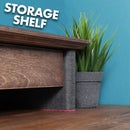Introduction: Steak Paddle Using an X-Carve CNC
I needed a way of applying even pressure to steak while it is cooking on a griddle pan. I designed this 'Steak Paddle' to help me with this. I included some 'fingers' to also enable me to get inbetween the grooves on the griddle pan, so I can mix my custom steak sauce easily.
I have a video on my YouTube channel of how I made it here:
I used an X-Carve cnc to make this project. If you have a cnc machine from Inventables you can load up this project in easel and start carving at this link:
https://www.inventables.com/projects/steak-paddle-...
You can of course make this paddle the more traditional way with a bandsaw/jigsaw and a multi tool for the inlay.
Tools Used:
- X-Carve cnc machine
- Drill
- Belt Sander
- Sharp Chisel
Materials Used:
- American Black Walnut
- Milliput Epoxy Putty
- Glue
- Dowels
- Raw Linseed Oil
Step 1: Cutting Out the Body & Handle
I made my design for the paddle in sketchup and then converted the design into 2D vector files. Easel uses vector files so I used inkscape to convert them to svg.
I simply loaded the files into easel (the software used with the X-Carve) and let it carve out the shapes for me. It leaves small tabs to stop the pieces moving around when the router bit cuts through the material. I removed these with a sharp chissel.
You can of course print of the images and use them as a template to cut out the shape with a bandsaw or jigsaw.
Step 2: Create the Inlay
Again I converted a image of a steak to an svg file so it would work in easel. I set the depth to 2mm deep as I would be adding epoxy putty as an inlay material later.
I centred the steak design in the middle of the paddle body and let the X-Carve do its thing.
I have previously used a small rotary tool to create my inlays. This can easily be done in the same way.
To create the inlay I used some black epoxy putty. I just mixed the 2 parts together and pushed it into the cut out steak on the paddle body. I mound the putty above the surface slightly because it is very easy to sand flush later. It doesnt clog the sandpaper which is great.
After leaving to set overnight I sanded the putty flush with the surface of the walnut to reveal the steak inlay below. I think it turned out great. I also sanded a slight curve towards the 'fingers' to give the paddle a more elegant look.
Step 3: Attach the Handle
I centred the handle on the body of the paddle and drew around where it met the body. This gave me 2 squares that I could join the corners to find the centre. I did the same on the bottom of the handle too, this will show me where to drill for the dowels.
I drilled down about 15mm using a 6mm drill bit. I was left with 2 holes in the body and 2 in the handle that line up perfectly. Then I just added a small amount of glue to 2 dowel and pushed them into the holes I had drilled in the handle. I then pushed the handle with the dowels into the holes on the body and cleaned the glue squeeze out with a damp paper towel.
I left this overnight to fully dry.
Step 4: Apply the Finish
I gave the whole piece a light sand by hand with 240 grit sandpaper.
I decided to use raw linseed oil as this was the only food safe finish I have. I think a butcher block oil would be an ideal choice for this.
Please noted that raw linseed oil is very different to boiled linseed oil. Boiled linseed oil contains metal fragments that help with drying times and this of course is not food safe.
I wiped on 3 coats with a paper towel leaving a few hours between each coat to let them soak into the walnut.
I can now put it to work cooking my favourite meal. Steak!
I also made a video of how I cook my perfect steak here:
https://youtu.be/rruLtl3W89w













